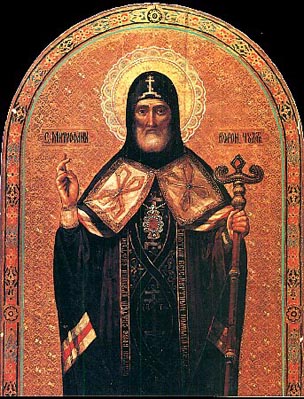
The Uncovering of the Relics of Sainted Mitrophan, Bishop of Voronezh (1832)
Commemorated on August 7, November 23
The memory of the deep piety and pastoral virtues of Saint Mitrophan (as schemamonk named Makarii) was revered as sacred at Voronezh, back from the time of his death (+ 23 November 1703). His successors, the Voronezh hierarchs, considered it their sacred duty to annually make remembrance of the first-hierarch of their flock, together with his parents, the priest Vasilii and Maria. The people of Voronezh and its surroundings came to the Annunciation cathedral, where at the place of his burial panikhida memorial services were made. Contributing to the intense remembrance of Saint Mitrophan was also his deathbed last-will bidding – to make prayers for him. For this the saint even during his lifetime had built at the cathedral a chapel in honour of the holy Archangel Michael (the heavenly patron-saint of the saint's baptismal name), and in it a special priest made early votive liturgies. Although new generations afterwards did not know the saint, they likewise reverently venerated his memory. The veracity of the sainthood of the first hierarch of the Voronezh diocese was likewise confirmed by his incorrupt relics, witnessed during the repeated transfers of them from one temple to another. And thus in the year 1718, the Voronezh metropolitan Pakhomii, in setting about the construction of a new cathedral, gave orders to demolish the old Annunciation cathedral, during which time the body of Saint Mitrophan was temporarily transferred into the church of the Unburnt Bush [as seen by Moses]. In 1735 the body of Saint Mitrophan was transferred into the new cathedral, during which time the non-decay of his relics was again witnessed. At the place of the burial of the saint, panikhidas were customarily made for him.

With the year 1820 it
was noticed, that the number of those venerating Saint Mitrophan and thronging
to Voronezh, had extraordinarily increased. Graced signs also increased. The
Voronezh archbishop Antonii II made repeated reports to the Holy Synod about
miracles, and he petitioned for a resolution on the glorification to sainthood
of the saint. The Holy Synod them prescribed watching for bestowals of grace,
received at the grave of Saint Mitrophan. In the year 1831, after witnessing to
the incorrupt body of the saint, archbishop Antonii together with commission
members of the Holy Synod – the Yaroslavl' archbishop Evgenii and
archimandrite Germogen of the Moscow Saviour-Androniev monastery, became
convinced in the miraculous intercession of Saint Mitrophan before the Throne
of God. The Holy Synod then issued its resolution adding Sainted Mitrophan into
the ranks of the Saints. Since then the Russian Church celebrates the memory of
the saint twice during the year: 23 November – on the day of repose, and on 7
August – on the day of glorification.
Archbishop Antonii II
(1827-1846) established in the Voronezh also the following feastdays in honour
of Sainted Mitrophan: 4 June, in memory of Sainted Mitrophanes, Patriarch of
Tsar'grad-Constantinople, as a day of "tezoimenie" or name-in-common
for Saint Mitrophan of Voronezh; 2 April – the saint's day of ordination to
bishop (in 1682); 11 December – the day of confirmation of the relics of Saint
Mitrophan (in 1831).
Saint Mitrophan left
behind a spiritual last-testament. Its original is preserved in the State
Historical Museum. Upon the testament is the unique handwritten authoritative
undersigning by the saint: "This spiritual dictate is attested to by me...
Bishop Mitrophan of Voronezh".
On the lower cover
(inside) is a gloss inscription from the XVIII Century: "This is the book
of testament or last-will of the Voronezh schema-monk Makarii, written in the
God-saved city of Voronezh, in the house of His Grave the bishop and schema-monk
Makarii, who reposed in the month of November on the 23rd day in the year 1703,
and was buried on the 4th day of December".
On the day preceding
the Uncovering of the Relics of Saint Mitrophan, the Voronezh archbishop
Antonii set about going to church, so as to lay out the new archbishop
vestments prepared for the relics. Suddenly he felt in himself such a weakness,
that he was barely able to go about his cell. Troubled by this, he sat and
pondered and then he heard a quiet voice: "Transgress not my legacy".
This he did not
understand right away, and instead thinking about his own plans, he gathered up
his strength and opened the closet wherein were the vestments, and there he
caught sight of the schema-garb, brought shortly before this by some unknown
monk, who had entrusted it to him and said, that it soon would be needed.
Seeing this
schema-garb, the Vladyka then realised, that the words, "Transgress not my
legacy", was actually the will of Saint Mitrophan, that they not place
upon his relics the archbishop vestiture, but rather leave them in schema-garb,
– indicating by this and by his extreme humility the deep spiritual connection
with his schema-monk patronal saint, the Monk Makarii of Unzhensk.
© 1996-2001 by translator Fr. S. Janos.